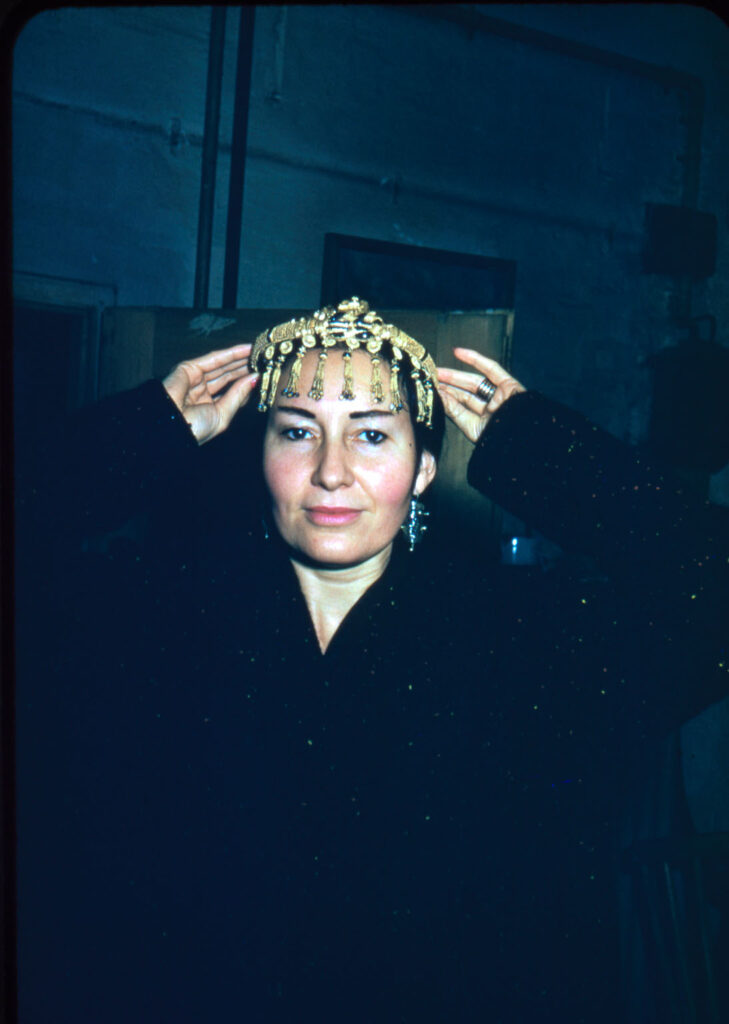Contributed by Kelin Baldridge, Project Archivist for the John Rhoden papers
Sometimes during the more mundane tasks, archivists have the absolute pleasure of discovering unexpected gems.

While cataloging the other day, I was faced with several images of Richenda Rhoden. These slides had no caption, no contextualizing background, and no corresponding images that could help with identification. When they arrived at PAFA, they were not grouped with other slides that could help with identification either.
For months, as we went through with processing and digitizing the John Rhoden papers, these slides remained entirely enigmatic. We had left them in a “Miscellaneous” folder, just hoping that one day they might make sense.
That day came last week when I started cataloging the miscellaneous travel slides. As an information professional, it was difficult to simply describe these incredible photos of Richenda as “unidentified”. I did what any archivist would’ve done–I went down a wormhole of Google searches.
Each time I had approached these images, I had assumed that Richenda was either purchasing jewelry or trying on traditional, but nondescript, pieces during her travels with John. I had not centered my research on the individual pieces of jewelry themselves as I could not fathom that she would be sporting priceless and culturally significant pieces of jewelry. That is where I went wrong. After becoming frustrated, I decided to take a shot in the dark and research the pieces of jewelry themselves.

Upon a quick search of tiaras, which led me more specifically to diadems, I was able to establish that Richenda was, in fact, wearing a significant piece of jewelry. This piece in particular is a Hellenistic Gold Diadem from 250 – 150 B.C. Though it is currently at the Metropolitan Museum of Art, it was at the Staatliche Antikensammlungen in Munich, Germany during the Rhodens’ travels. This discovery both gave us a location and approximate date and made the images that much more special.
Further research led to the discovery that the ring and cuff bracelet Richanda models in one of the images belonged to Queen Amanishakheto. Amanishakheto was a Kandake (meaning sister of the King of Kush, and due to matrilineal succession, the queen mother) of Kush. As a Kandake, she had a powerful role as regent. Amanishakheto reigned roughly from 10 B.C. to 1 A.D.
Richenda models pieces from a collection of jewelry found in her pyramid at Meroe (Beg. N6). In 1834, Italian treasure hunter Giuseppe Ferlini ransacked Amanishakheto’s resting place and destroyed her pyramid in search of her burial treasures. The pieces are now in the Egyptian Museums of Berlin and Munich, where Richenda encountered them.

It has been a little over a week since this finding and I am still awestruck by the fact that world class European museums were letting Richenda try on ancient and priceless pieces of their collections. It could be a sign of the times and changing reverence for historic objects, or is could be a result of the intoxicating effect she seemed to have on many of the people they met, as evidenced by the many mentions of her in European newspapers. Either way, it is yet another interesting little gem in the Rhoden papers that I am pleased to be able to share.
This project, Rediscovering John W. Rhoden: Processing, Cataloging, Rehousing, and Digitizing the John W. Rhoden papers, is funded in part by the National Endowment for the Humanities, a federal agency.
ABOUT THE NATIONAL ENDOWMENT FOR THE HUMANITIES
Created in 1965 as an independent federal agency, the National Endowment for the Humanities supports research and learning in history, literature, philosophy, and other areas of the humanities by funding selected, peer-reviewed proposals from around the nation. Additional information about the National Endowment for the Humanities and its grant programs is available at: www.neh.gov.